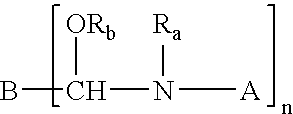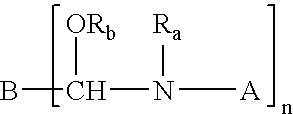Crosslinking composition
a crosslinking composition and aminoplast technology, applied in the field of aminoplast-based crosslinking compositions, can solve the problems of requiring relatively high temperatures to adequately crosslink the film, reducing the throughput of the film, and releasing formaldehyde as a volatile by-product under curing conditions,
- Summary
- Abstract
- Description
- Claims
- Application Information
AI Technical Summary
Problems solved by technology
Method used
Image
Examples
example 1
Preparation of Glycoluril-Urea Alkylaldehyde Resin
[0080]Into a suitable flask was placed 1.5 grams of Na2CO3 and 139 grams of water at room temperature. To the well-stirred solution was added 150 grams of a 50% aqueous glutaraldehyde solution. The temperature was reduced and maintained at approximately 25° C. by cooling in an ice bath whereby 72.5 grams of propionaldehyde and then 35.5 grams of glycoluril was added with stirring. The temperature was then increased to approximately 35° C. and held at that temperature until the solution became clear. Approximately 30 grams of urea was then added and the reaction was allowed to react for approximately 0.5 hours.
[0081]After this time, 250 grams anhydrous MeOH with 2.5 grams of added 97% H2SO4 was added to the mixture with stirring, and the temperature was maintained at 25° C. (ice bath) for about 1 hour. The reaction mixture was then neutralized with 50% NaOH to pH 8 to 8.2. The reaction mixture was then stripped under good vacuum at a ...
example 2
Coating Composition Containing Glycoluril-Urea Alkylaldehyde Resin
[0083]A coatings formulation was prepared with the crosslinking resin of Example 1 by adding 3.0 grams of Dynotol® T-49emp alkyld backbone resin (85% solids in alcohol) to 3.0 grams of the crosslinking resin of Example 1, 0.3 grams of CYCAT® 4040 catalyst (40.0% para-toluenesulfonic acid monohydrate in isopropyl alcohol) and 1.0 gram of acetone solvent. The formulation was applied as a thin film, approximately 2 mils thick, with a wire wound cator (#52) to iron phosphate treated cold roll steel panels. The panels were then allowed to cure at room temperature (23° to 25° C.) for seven days. The films did not discolor and had greater than 100 double rubs methyl ethyl ketone (MEK) solvent resistance. A control panel without the crosslinking resin containing Dynotol T-49emp plus 0.3 grams of CYCAT 4040 catalyst and 1.0 gram of acetone solvent had less than 3 MEK double rubs solvent resistance and were yellowed.
example 3
Preparation of Melamine-Urea Alkylaldehyde Resin
[0084]To a suitable flask was charged 35 grams of water and 0.50 grams of K2CO3. The resulting solution was warmed to 40° C. and 30.0 grams of urea was charged and allowed to dissolve with good stirring. To this reaction mixture was charged 12.6 grams of melamine with good stirring. To this slurry was slowly added 40.6 grams of propionaldehyde keeping the temperature below 55° C. to 57° C. After complete addition, the reaction mixture was refluxed for one hour and then 30.0 grams of 50% glutaraldehyde was added after cooling to room temperature. After stirring several hours at room temperature (22° to 25° C.), the reaction mixture became homogenous and 135 grams of anhydrous methanol was added and the pH adjusted to 4.3 with 5.5 grams of 70% HNO3. The batch was allowed to react at room temperature for about one hour and then the pH was adjusted to 8.1 with 5.5 grams of 50% NaOH. The batch was then stripped under good vacuum to remove t...
PUM
| Property | Measurement | Unit |
|---|---|---|
| temperature | aaaaa | aaaaa |
| temperature | aaaaa | aaaaa |
| temperature | aaaaa | aaaaa |
Abstract
Description
Claims
Application Information
 Login to View More
Login to View More - R&D
- Intellectual Property
- Life Sciences
- Materials
- Tech Scout
- Unparalleled Data Quality
- Higher Quality Content
- 60% Fewer Hallucinations
Browse by: Latest US Patents, China's latest patents, Technical Efficacy Thesaurus, Application Domain, Technology Topic, Popular Technical Reports.
© 2025 PatSnap. All rights reserved.Legal|Privacy policy|Modern Slavery Act Transparency Statement|Sitemap|About US| Contact US: help@patsnap.com



